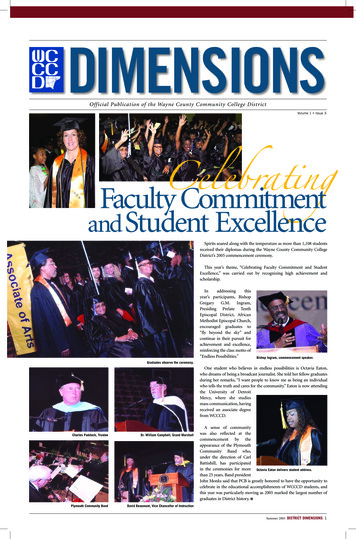
Transcription
DIMENSIONSOfficial Publication of the Wayne County Community College DistrictVolume 1 Issue 3CelebratingFaculty Commitmentand Student ExcellenceSpirits soared along with the temperature as more than 1,108 studentsreceived their diplomas during the Wayne County Community CollegeDistrict’s 2005 commencement ceremony.This year’s theme, “Celebrating Faculty Commitment and StudentExcellence,” was carried out by recognizing high achievement andscholarship.Inaddressingthisyear’s participants, BishopGregaryG.M. Ingram,Presiding Prelate TenthEpiscopal District, AfricanMethodist Episcopal Church,encouraged graduates to“fly beyond the sky” andcontinue in their pursuit forachievement and excellence,reinforcing the class motto of“Endless Possibilities.”Bishop Ingram, commencement speaker.Graduates observe the ceremony.One student who believes in endless possibilities is Octavia Eaton,who dreams of being a broadcast journalist. She told her fellow graduatesduring her remarks, “I want people to know me as being an individualwho tells the truth and cares for the community.” Eaton is now attendingthe University of DetroitMercy, where she studiesmass communication, havingreceived an associate degreefrom WCCCD.Charles Paddock, TrusteeDr. William Campbell, Grand MarshallPlymouth Community BandDavid Beaumont, Vice Chancellor of InstructionA sense of communitywas also reflected at thecommencement by theappearance of the PlymouthCommunity Band who,under the direction of CarlBattishill, has participatedin the ceremonies for more Octavia Eaton delivers student address.than 25 years. Band presidentJohn Monks said that PCB is greatly honored to have the opportunity tocelebrate in the educational accomplishments of WCCCD students, andthis year was particularly moving as 2005 marked the largest number ofgraduates in District history. Summer 2005 DISTRICT DIMENSIONS 1
Contents1 Celebrating Faculty Commitmentand Student Excellence2 ContentsOpen Door InstituteLeadership RoundtableBoard of TrusteesCampus Locations3 MESSAGE AND UPDATESSCT Banner ImplementationUpdateLetter from Dr. IveryBookworm ClubSCT Banner Summit4 SPECIAL FEATUREMexico 20055 CAREER FOCUSPharmacy Tech Programmay be the Right PrescriptionAllied Health CornerMedical Billing Specialist6 DISTRICT NOTESSalute to Retiring StaffNewsmakersIn the Spotlight:David Beaumont7 FACULTY NOTESWCCCD Program CoordinatorGoes to the DogsStanding on the “Roof of Africa”8 SUCCESS STORIESJourneys of ConscienceDr. Ivery’s book signing event9 HIGHLIGHTSThe Cherry CommissionsNot Until You Know My StoryCommunity Traditions10 CULTURAL EVENTSCampus Round-upBest Practices: WCCCD Teamvisits Houston CommunityCollege System11 DISTRICTRoostertail Banquet Celebration12-13SPECIAL FEATUREThe Original MembersOpen Door InstituteWCCCD is fulfilling its promiseto provide quality education for thosepersons who experience barriers inpursuing their educational objectives.Frequently identified as at-risk students,Roueche and Roueche (1993) describethese students as not only academicallyunderprepared for college, but lackingexternal support systems, having littlefinancial resources, and high failureexpectations. Furthermore, these authorsoffer an explanation of the characteristicsof a weak self-concept, manifested in nontraditional and atrisk students. This phenomenon, coupled with prior schoolexperiences, may result in the student being wary of theireducational surroundings. The student’s disbelief in his or herown ability may lead to a self-fulfilling prophecy of failure. Thisfailure is demonstrated by the student’s behavior, such as nothaving proper supplies, not completing assignments, hostilitytowards peers and instructors, or conversely, not participatingin class activities. According to these authors, unlike thetraditional academically prepared student who is motivatedand goal-oriented, the at-risk student has unrealistic goals andis motivated not by success, but by failure, driven by harsheconomic conditions.Recognizing this, along with other changing studentdemographics, such as an increase in the number of studentswith physical challenges, and English as a Second Languagestudents, the District has broadened and improved the servicesprovided to meet the needs of at-risk students. The Open DoorCAMPUS LOCATIONS14 DISTRICT NEWSDr. Ivery HonoredDid You Know?15 SPECIAL FEATUREDistance EducationEnrollement Trends16 Graduation MemoriesBoard ofTrusteesLarry LewisChairperson, District 621000 Northline RoadTaylor, MI 48180734.946.35001001 W. Fort St.Detroit, MI 48226313.496.2758Charles PaddockVice Chairperson, District 8Mary Ellen StempfleSecretary, District 1Juanita C. FordTreasurer, District 25901 ConnerDetroit, MI 48213313.922.3311Alan AndersonMember, District 7Frank HaydenMember, District 38551 Greenfield RoadDetroit, MI 48228313.943.4000Elizabeth PotterMember, District 9Myron WahlsMember, District 4Denise Wellons-GloverMember, District 52 DISTRICT DIMENSIONS Summer 20059555 Haggerty RoadBelleville, MI 48111734.699.7008Institute provides student services such asfinancial aid, tutorial services, career andacademic counseling, General EducationDegree, and coordination of services.The Open Door Institute will serve asa catalyst to coordinate, integrate, andimprove services in all areas of the District.Advocacy and Institutional Change; theInstitute seeks to bring about effectiveinstitutional responses to individual studentissues and to promote institutional changesin policies, procedures, programs, servicesand administration. Community Development; the Open DoorInstitute will interface with community agencies, organizations,and groups to remove barriers to educational success. The finalrole of the Institute is that of National Leadership which willbring about positive changes in the way community collegesacross the country respond to the needs of underprepared andunderserved populations.Dr. Ivery has made it clear that the District must reachthose persons in our community who may not believe thatcollege is possible for them. Education can be their “savinggrace.” If we are to maintain the mission of the open doorcommunity college, we must make student success a majorfocus. To that end, The Open Door Leadership Team, ledby John Bolden, vice chancellor for student services, willwork collaboratively with administrators, faculty, and staffto encourage and support the Open Door Institute. WCCCDwill take the helm and share its best practices by meetingdiverse student needs around the world. WCCCD LaunchesLeadershipRoundtableRealizing the critical role senior leaders canplay in mentoring and developing the futureleaders of tomorrow, WCCCD launched aspecial Leadership Roundtable program inMay.Thisyear-longpremierleadershipdevelopment program identifies and preparesWCCCD staff members whose workperformance indicates the potential for careeradvancement. The Leadership Roundtableis sponsored by the Office of the Chancellor.Dr. Gunder Myran, Senior Consultant tothe Chancellor, serves as the Roundtableleader and facilitator.Approximately 20 staff members wereselected for the class of 2005-06. Referredto as leadership associates, they will attendweekly leadership study sessions and willapply the leadership skills they are learning tostrategic institutional development initiatives.Although they will continue to perform theirregularly assigned duties, in an effort to gainpractical leadership experience, they will benefitfrom workshops with guest speakers, travelto other outstanding community colleges,and be involved in District-wide initiativesencompassed in the Pathways to the Futureprogram, including preparation for the HigherLearning Commission re-accreditation.
M E S S A G E A N D U P D AT E SSCT BannerImplementationUpdateThe institutional andcultural paradigmshift towards a unifiedcomputer process isimplicit in the utilizationof banner .In April 2005, admission and registrationsegments of the student module went “live” onall campuses. This achievement is the result ofstrong organizational leadership, team building,infrastructure development, training, and anoverall positive attitude of empowerment. End-usertraining will continue for academic administrationand instructors, counselors and academic advisors,student service administrative staff, cashiers, andfaculty. All segments for the student module willbe operational prior to July 18, 2005 when theBanner System will become WCCCD’s authoritativeoperational system.CHANCELLOR’S MESSAGE“Progress Has Been Made,Promises Have Been Kept”It is an exciting time in the history of Wayne County Community College District. Our commitmentto providing the highest quality of educational services to the communities throughout our entire serviceregion is reflected in the hard work and dedication of faculty, administration, and staff.This has been a year of many milestones, including a celebration recognizing faculty who have servedthe District for 35 years and the Class of 2005, our largest graduating class with over 1,100 students.More than 550 students graduated with a GPA of 3.0 or better.Student enrollment is also at a historic high. Program offerings have been expanded and designedto meet the increasing demands and needs of the community. Campus facilities improvement projectsare currently underway at all five campuses, creating an educational environment that is inviting andconducive to learning.As a team, we continue to move forward and offer expanded program offerings in health sciences,continuing education, and workforce development. Additionally, we are enhancing student services,training and professional development opportunities for the District staff and faculty, and expandingour highly effective public outreach and information campaigns.In line with the District’s unconditional commitment to openness, transparency, and accountability,we have taken a national lead in making our finances and day-to-day operations more accessible to thepublic by posting on our Web site detailed financial, operational, and performance information that iscurrent, updated on a regular basis.We value the trust that has been placed in us and have raised the bar for public disclosure as wecontinue to provide better services and opportunities for our students and the communities we serve.We will continue to work at making WCCCD one of the finest educational institutions in thecountry.Sincerely,Curtis L. Ivery,Chancellor, WCCCDBOOKWORM CLUBJackie Rhodes, staff memberThe finance module will go on-line July 1, 2005and 80% of the end-users have completed training.As with all SCT Banner modules, training will beavailable when required. A series of mock parallelrun exercises began May 16, 2005, and additionalmocks will occur prior to cut over in July. End-usertraining is ongoing.The Bookworm Club, a literacy program for kids run by WCCCD, meets in two-hour sessions at each ofthe College’s five campus locations. The club has stories, songs, and other activities to improve literacyfor children and has strong support since such a high percentage of adults in Detroit are functionallyilliterate, according to a government report. Dr. Curtis L. Ivery and his wife Ola have made it their“personal mission” according to The Detroit Free Press. A big, fuzzy worm leads the sessions that are freeand open to parents and children ages 3-7 across Metro Detroit. The bookworm encourages the childrento participate in kindergarten songs, map reading, or other mentally challenging fun activities. Accordingto The Detroit Free Press, “The most recent comprehensive national study of literacy, conducted in 1998by the National Institute for Literacy, part of the U. S. Department of Education, found that 47 percentof Detroit residents are at the lowest level of literacy, as were 59 percent in Highland Park, 38 percent inInkster, 17 percent in Warren, and 24 percent in Southfield”.The club, while being sponsored by WCCCD, is inexpensive to run since volunteers staff it. In additionto learning to read, there are additional incentives for children to participate. School supplies, gifts,books and a free lunch are adding up to make this a winning opportunity for all. SCT Banner SummitIN MARCH 2005, SIX WCCCD BANNER MODULE REPRESENTATIVES, INCLUDING ADMINISTRATIVELEADERSHIP, ATTENDED THE ANNUAL SCT BANNER SUMMIT IN HONOLULU, HAWAII.“The Banner Conference provided over 700 sessions,” said Patricia Hawkens, District Dean for StudentServices & Registrar. “The opportunity to meet and obtain advice from current users was enlightening. Asa member of the Banner Team, this conference provided me the opportunity to see the vision, hard work,great rewards, and benefits available soon to our students, faculty and staff,” she said. Clayton Fritz and Treneece WestThe financial aid module started 2005-2006processing financial aid records in the Bannerproduction database. To date, over 11,000 studentswere issued tracking requirement letters generatedfrom Banner data.The team for the human resources module isnow building tables in Banner. The SCT Systemeducation sessions are occurring on site. Thismodule is scheduled to go on-line in 2006. Patricia A. Hawkens Dr. Bernadette Spencer, Rahel Tadesse, and Kiran SekhriSummer 2005 DISTRICT DIMENSIONS 3
P E C I A LFEATUREF E AT U R ESSPECIALWelcomeBienvenidos!WCCCD students, accompanied byDavid C. Butty and Mary Jones, spent 11days studying Mexican culture, language,and government at the Don QuijoteSchool of Spanish, Mexican Culture, andGovernment this past spring. They areamazed how Mexicans respect religion.The church house doors are never shutand passersby would stop in front of thechurch, take off their hat and make thesign of the cross.Thirty-three WCCCD students experiencelife and culture in Guanajuato, Mexico.Guide Antonio Roche Yebre,nicknamed “Rigo”, led the studentsthrough the cities of Delores Hidalgoand San Miguel do Allende. He alsoled a tour of the City of Guanajuato,during which time students visitedthe Spanish Inquisition Museum.Yolanda M. Brock said, beforegoing to Mexico, she was ignorantabout the culture and her view of thecountry was based on the images in theAmerican media, such as illegal aliensand migrant workers. The study abroadchanged her mind. “It was a trip full ofadventure, beautiful sights, interestingand educational occurrences.” Anotherstudent, Deneen White was thankfulto the College for the opportunity tostudy and experience another culture.It is an experience all students saythey will never forget. Mexico is known for its architectural design, as seen in this church.Mary Jones, associate dean of student services, captures special moments with her digital cameraduring the awarding of certificates.Victoria Wells cried for joy as students and instructorsshared the moment with her.Sally Gibrael walks to the cheers of students and instructors when she accepts hercertificate of achievement.WCCCD students appear with their cooking instructor Ma. Elena Hernandez Deloera(center).4 DISTRICT DIMENSIONS Summer 2005
R ATF OUCRUESS P E CCI AARLE FE EPharmacy TechProgrammay be the RightPrescriptionSO, YOU THOUGHT THE PHARMACIST FILLED YOURPRESCRIPTIONS? TECHNICALLY, IT IS DONE BY A PHARMACYMedical BillingSpecialistsFIND SUCCESS IN THEWORKFORCEIs 200 hours of class time and working five, 40-hour weeks forfree worth a 65 percent chance of getting a job?At least 72 persons per year that enroll in Wayne CountyCommunity College District’s (WCCCD) Medical Billing SpecialistFast Track program think so. Students can take additional coursework to earn an Associate of Applied Science degree.ASSISTANT AND QUITE POSSIBLY A WCCCD PHARMACYTECHNOLOGY PROGRAM GRADUATE.Assistants are also responsible for measuring IV unit dose orders, fillingthe robotic machines that dispense medications, and entering orders into thepharmacy’s computer system.“Students assist the pharmacist in filling prescriptions, and complete most ofthe tasks the pharmacist used to do,” said Dick Kuschinsky, who runs this program.He added that a pharmacist’smain job today is overseeing theassistant.Sounds like a job for you?Only 18 students are acceptedeach semester for the two-semesterprogram that then requires anothereight weeks of clinical experiencefour in a hospital pharmacy andfour at an ambulatory pharmacysuch as CVS.Uponcompletingtheircoursework, students are assignedinternships arranged by WCCCD.Kuschinsky said the college has anagreement to place interns withCVS Pharmacy and local hospitals.Adrienne Shipps coaches student“Our students are 18 to 80 years old,” said Adrienne Shipps,program coordinator. “We have retirees looking for part-timeemployment, some have been homemakers for 20 years andothers are looking for complete career changes.”Dick Kuschinsky with students.Applicants must be at least 18 years old and have a high school diploma orGeneral Education Degree to be considered for the program. Interested studentsmust complete an assessment to determine proficiency in math, science andreading as well as pass a personal interview.“There’s a lot of homework,” Kuschinsky cautioned.Students who wish to go on and earn an Associate of Science Degree can enrollin the basic required courses in their second year of study. That degree couldnet a pharmacy assistant amanagement position at acommunity pharmacy.Kuschinsky said studentshave a very good chance offinding employment aftercompleting their internship.Of the recent 12 graduates,Kuschinsky said three werehired by a hospital, eightaccepted a position at a CVSPharmacy, and the other choseto seek a four-year degree at alocal university. The certificate program is limited to 24 students per term andincludes 20 weeks of course work including medical terminology,abstracting medical information from patient records, andcompleting insurance claims in preparation for entry-levelpositions. Shipps said students are also taught resume writing,interviewing skills, and dressing for success before they embarkon a five-week, 40-hour per week internship in the medicalbilling field.Students are not paid for their internships, but Shipps said it’s“hands-on training that the student cannot buy.”“The internship gives the facility an opportunity to take a lookat the student’s abilities and see if there’s a place for them intheir organization,” Shipps said, adding there is a 65 percentsuccessful placement rate upon completion of the internship.Internship Students are assigned to one of 20 facilities workingwith the college, including Henry Ford Hospital, St. Mary’sHospital, Garden City Hospital and several independent medicalbilling companies. Locations are scattered across the metroDetroit area from as far west as Novi down to Wyandotte andover to Troy. Shipps said students are advised that WCCCDcannot guarantee them an internship close to home, but theyare welcome to find their own with approval from Shipps.Shipps said the internships give students an opportunity to applywhat they have learned in the classroom to the workplace andprove they understand the job. “They have an opportunity tosell themselves on the fact that they have some experience,”Shipps said.“We have had excellent feedback about how well our studentsare prepared.” Kuschinsky demonstrates perscription preparation.Summer 2005 DISTRICT DIMENSIONS 5
DSTRICT NOTESS IPECIALFEATUREWCCCD Salutes Retiring StaffMARIE WELTRecords/Registration Technicianat the Western CampusWelt started with WCCCD inSeptember, 1986.IN HONOR OF THEIR DEDICATED AND VALUABLE SERVICE TO THE DISTRICTALMA LUISOSHIRLEY CROSBYLibrary Technician at theNorthwest CampusCrosby began teaching at WCCCDin July, 1979Administrative Specialist at theDowntown CampusLuiso started in April, 1987.INEZ PEARSONAssociate District Director forFinancial Aid in the CentralAdministration BuildingPearson joined WCCCD in June,1982.DR. KAREN BRANTLEYChief Academic Officer at theWestern CampusDr. Brantley started with WCCCDin 1983.I enrolled at the College andobtained my Associate’s of Arts degree in 1988 alongwith one of my seven children. Of my seven children,six attended and three received their degrees at theCollege and went on to obtain their bachelor’s degrees.My husband also attended. Now, the third generationis attending. My grandson enrolled at WCCCD in2004. My family would like to continue what hasbecome a tradition.During my tenure at the College,I have worked in Costal Environmental Studies,Administrative Office at the Northwest Campus,Continuing Education at the Downtown Campus,Financial Aid at the Central Administration Building,and the Learning Resource Center at the Northwest,Downriver, and Western Campuses.”LARRAINE WATSONFinancial Aid Specialist in theCentral Administration BuildingWatson started with WCCCD inJanuary, 1983.JULIA AMOSDistrict Financial Aid Advisorin the Central AdministrationBuildingAmos started with WCCCD inOctober, 1985.NWELCOMEewsmCONGRATULATIONS!a Denise Shannon has joined The YMCA of Metropolitan DetroitWCCCD as the interim districtdirector of Student Services. In herrole, she has already begun to workon projects such as tech-prep,four-year university articulations,bilingual pathways to teaching, theStudent Services Newsletter, andSpecial Pops. Under the leadershipof John Bolden, Vice Chancellor of Student Services, Denisewill assist with projects and programs as needed in StudentServices.has named WCCCD’s Vice Chancellorfor Student Services John Bolden asone of their Minority Achievers for 2005.The Minority Achievers program linkspositive adult role models with Detroitarea youth. Dr. Jacqueline Hodges,President of WCCCD’s DowntownCampus, has accepted an invitation toserve on The Foster Parent RecruitmentAdvisory Taskforce, supported by theGannett Foundation.IN THE SPOTLIGHT:David BeaumontIf you hear the classic rock sounds of Rare Earthreverberating in the parking lot behind the WCCCDadministration building, they’re coming from DavidBeaumont’s car. “I need something to increase mypulse rate,” said the Vice Chancellor of Instruction/Provost of his morning musical routine.Beaumont, who holds a Master of Arts in collegestudent guidance and counseling from EasternMichigan University, is currently working on hisdoctorate in higher education administration with amasters of science in economic development andurban planning from the University of Toledo. Hejoined WCCCD in 2002 and was recently appointedVice Chancellor of Instruction/Provost.His numerous duties take up a great deal of his life.When asked if he remembers what the inside of hishome looks like in the daylight, he responded, “I don’tsee it often, but I recognize it when I’m there.”As a typical day for Beaumont doesn’t exist – everyday has new and unique challenges. While most wouldconsider administering and supporting academicprograms one and the same, they are really separateentities.Administering academic programs includes all ofthe instruction and research for WCCCD. Beaumontis responsible for leading the entire institution6 DISTRICT DIMENSIONS Summer 2005on academic issues,allowing the Chancellorto focus on developingthe overall strategy atWCCCD.Beaumont’spositionrequiresagreat deal of attentionto implementation aswell as consideration forinstitutional vision.Other crucial factors forthe academic side includerecruiting the people andproviding the tools andresources necessary to ensure that WCCCD is meetingthe challenges and goals set forth by the Board ofDirectors and the Chancellor. The support of theacademic programs includes student affairs, learningcenters, information technology and institutionalplanning. Most of the duties involved with the supportof WCCCD’s programs take place behind the scene.When he does get a chance to relax, Beaumontcollects art and says his Detroit home houses acollection of paintings, prints and photographsarranged in themes. His favorite pieces are photographsof nature, African American works and those depictingthe performing arts. He doesn’t have a favorite artistDR. RICHARD GALANTWestern Campus PresidentGalant began working withWCCCD in July, 2002.As I prepare to retire at the end ofJune, it is my time to say “good-bye”to those I have known and worked with at the WayneCounty Community College District, most especiallyat the Western Campus. Although I have only workedwith many of you for a relatively short time, I thankyou for having been your colleague in the workplaceand wish each one of you future success. You haveenriched my life very much and taught me a great dealabout what it means to be a better person and valuededucator. To each of you, I say, “Ave et vale.”HUBERT LEE SHANNONAcademic Support Coordinator at theDowntown CampusShannon started with WCCCD in February, 1984.(Photo unavailable)kers Mathew Green,Emergency Medicalinstructor, was recognizedas “Firefighter of theYear” during this year’sFarmington HillsAmerican Legion Post’sMemorial Day Parade.Green has served as aninstructor at the collegefor many years.and collects solely on the work’s appeal to hissenses.Beaumont said he developed a strong interest inthe performing arts while working as a stage handat Eastern Michigan University where he earnedhis Bachelor of Science degree in psychologywith a minor in business management.In addition to his love of art, Beaumontenjoys his eclectic taste in music that runs thegamut from Rare Earth, War and Jimi Hendrix,to classical. He’s always adding to his vastcollection, especially if he learns of re-releasesof 70s classics. Sunday mornings, however, therock music stays in the CD cases, replaced bythe strains of New Age as he relaxes with themorning paper.Classical music is also what he brings alongon his annual hiking trip to the Rocky or WhiteMountains. “I like to get out there for a week andnot talk to anyone,” he said, adding his favorite campsite is next to a waterfall where very few other camperstread. He recalls waking one night, thinking someonewas shining a light into his tent, only to find it was thebright moonlight that woke him from his slumber.While he covets his time alone, Beaumont alsoenjoys entertaining family and friends with hiscooking. He doesn’t have a favorite recipe and franklyadmits that he doesn’t use them. He makes it up ashe goes along and has mastered his mother’s secretrecipe for macaroni and cheese.Don’t bother asking – he’s not spilling.
CUY ATN OUTRE ESS P E FACIAL LTFEgoes Wto thedogsWCCCD PROGRAM COORDINATORorking outdoors in freezing temperatures and several feetof snow does not sound like heaven to most of us. But forMarianne Robson, Coordinator forWCCCD’s Veterinary Technology program, honingher veterinary technician skills as a volunteer for theIditarod Trail Sled Dog race can’t be topped.The race is on!Dr Robson and musherStudent pleased with dog’s performance“If I had to describe heaven, that is what it would be,”Robson said of her 10-day stay in Anchorage, Alaska. Herjob was to perform pre-screening tests to confirm canineentrants were healthy enough to make the 17 day trip onsnow covered trails through mountain ranges, frozenrivers, forests, and tundra from Anchorage to Nome.Inspired by a former student’s presentation on theannual Alaskan dog sled race, Robson turned to theevent web site and learned volunteers with veterinarytechnology skills and just plain folks were being sought.Correspondence with Jan Bulloch, Head Vet Technicianfor the Iditarod, led to an invitation to Robson and astudent to work at the event.After getting approval from WCCCD officials for thetrip, Robson polled her students in search of a partner.Several enthusiastically volunteered. To determine whowould go, she and Vet Tech Program Director Dr. KarenHrapkiewicz devised a selection process based on thestudent’s grades, community service, and attendance.The list was cut to four and a lottery was held to select thewinner. Catherine Sutton held the winning ticket.Upon arrival in Anchorage, Robson and Suttonwere immediately put to work pre-screening thecanine entrants.Robson was surprised to see Iditarod dogs are notnecessarily Siberian Huskies. The vast majority, she said,are physically fit “mutts” averaging about 60 pounds.“These dogs aren’t your couch potato dogs like we haveat home,” she said.During the two days spent conducting pre-screenings,the pair helped test a minimum of 240 dogs per dayfor general overall health to problems such as anemia,diabetes, and pregnancy. Because the animals resist beingindoors, the majority of testing was conducted outdoorsand in the snow amid 40-plus degree temperatures.Each animal was also given an Electrocardiogram(EKG); the results of which startled Robson. The resultsof the first EKG she conducted indicated the animal wasclose to death. She soon learned because the animals areso physically fit, their heart rates are much lower than thetypical house pet.“I told them I wanted to do the test again because I wasconcerned and they laughed at me,” she said of the seasonedpre-screeners who were accustomed to the results.Working so closely with the animals gave Robson anopportunity to develop relationships with the mushers,many of who requested that only she work on their dogs.She was surprised to note the majority of mushers are farStaff conducting pre-screeningfrom wealthy and some downright indigent, however theanimals don’t suffer in the least.“These animals are exceptionally well cared for,” shesaid, adding she was very impressed by the connection theowners have with their dogs.Robson said she and Sutton were able to stay inAnchorage long enough to see the ceremonial startof the race – and to get invited back next year alongwith a few students.And she accepted.“If I could arrange it, I would take the whole month ofFebruary off to work with those dogs,” she said. Standing on the“Roof of Africa”by Ka ren Hr apkiew icz, D ire c tor, Ve ter inar y Te chnolo g y Pro g r amIt is no wonder Kilimanjaro is called “Homeof God” by the local people. Kilimanjaro, at anelevation of 19,341 feet, is cro
SCT Banner Summit. IN MARCH 2005, SIX WCCCD BANNER MODULE REPRESENTATIVES, INCLUDING ADMINISTRATIVE LEADERSHIP, ATTENDED THE ANNUAL SCT BANNER SUMMIT IN HONOLULU, HAWAII. “The Banner Conference provided over 700 sessions,” said Patricia Haw











